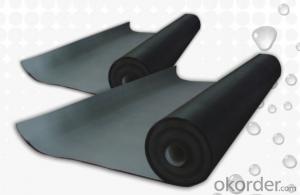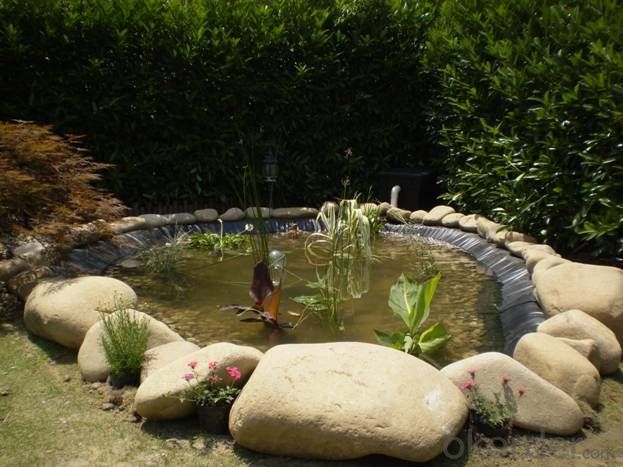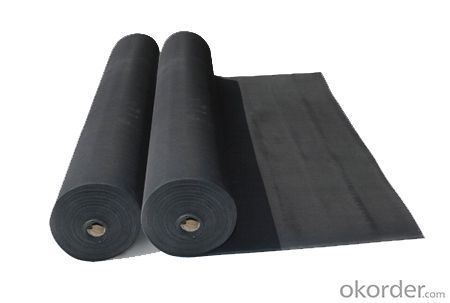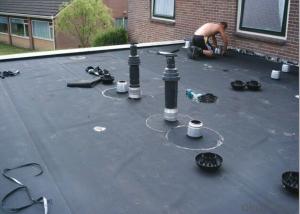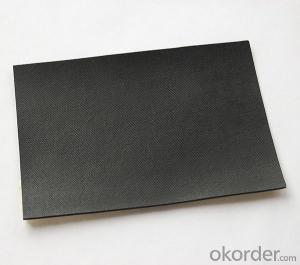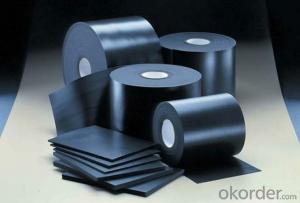EPDM Rubber Coiled Waterproof Membrane for Multi Function
- Loading Port:
- Shanghai
- Payment Terms:
- TT OR LC
- Min Order Qty:
- 50000 m²
- Supply Capability:
- 5000000 m²/month
OKorder Service Pledge
OKorder Financial Service
You Might Also Like
EPDM Rubber Coiled Waterproof Membrane for Multi Function
Description Of EPDM Rubber Coiled Waterproof Membrane for Multi Function:
•EPDM waterproof sheet has excellent anti-ozone-aging performance, able to resist ultraviolet light and corrosion of many chemical corrosive materials in the atmosphere
•It has high tensile strength, high ductility and strong retractility, it has excellent crack resistance, able to effect waterproof function even with tiny vibration of buildings.
• Excellent resistance to ozone, oxidation and sunlight.
• Resistance to chemicals; resistant to most inorganic products.
Main Features of EPDM Rubber Coiled Waterproof Membrane for Multi Function:
1>Excellent antiaging performance, service life up to 50 years
2>Working well with in 40C to 100C,it canbe constructed with a single layer in ambient temperature.
3>Waterproofing on various kinds of underground project,industrial of civil buildings and structures.
4>high extension rate, high tensile strength, small size changes at heat treatment
5>Good plant roots penetrability resistance and can be made waterproofing layer of planting roof
6>Special modified molecular structure ,effectively resolving the current domestic and foreign glue joint problem.
7>Good low temperature flexibility, and good performance of adapting to ambient temperature changes.
8>Convenient application ,solid joint, no environment pollution
9>chemical corrosion Resistance, can be used for special occasions
10>Convenient maitenance, low cost.
Specifications of EPDM Rubber Coiled Waterproof Membrane for Multi Function:
| Material | EPDM Rubber |
| Size | 1.2m (width)*20m (length) or customized, weldable type 2.05m or 4m width |
| Thick | 1.2mm, 1.5mm, 2.0mm |
| Type | Vulcanized & Weldable |
| Pattern | Non-reinforced (homogeneous) |
| Certificate | ISO9001/14001 |
Applications of EPDM Rubber Coiled Waterproof Membrane for Multi Function:
Widely used in roofs, basement, toilet ,swimming pool, and all kinds of industry and civil building waterproofing, reservoir, vivicism, bridge, underground, tunnel and dam waterproofing ,especially to the keystone waterproofing projects which is durability, high corrosion resistance and easy deformation.

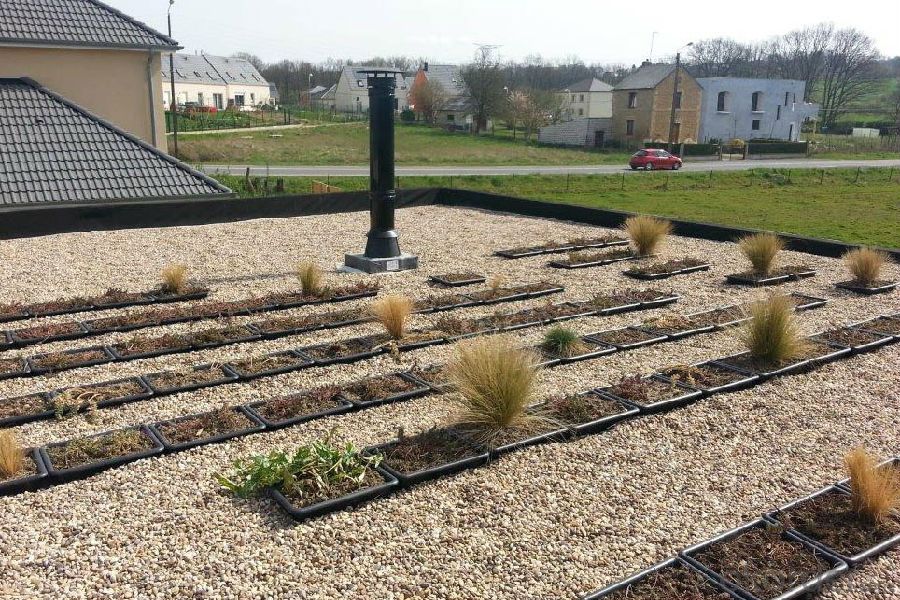

IMages of EPDM Rubber Coiled Waterproof Membrane for Multi Function:
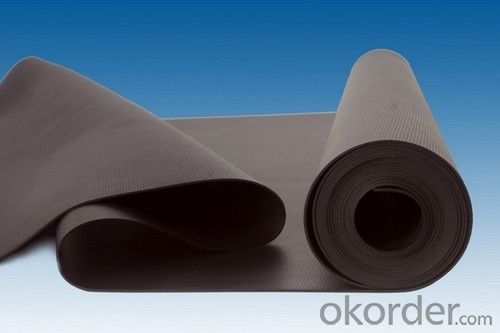
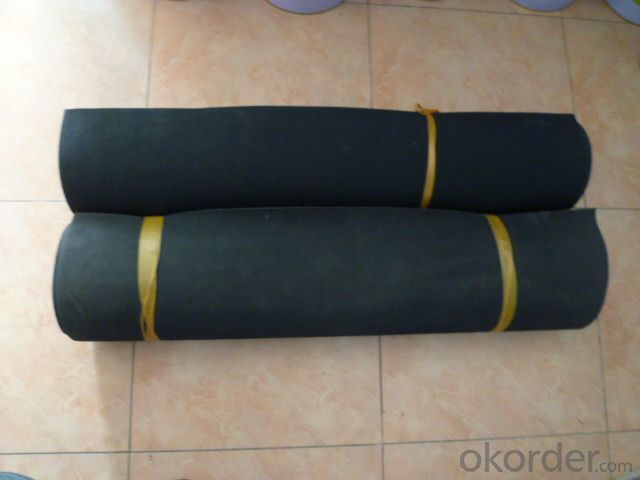


FAQ of EPDM Rubber Coiled Waterproof Membrane for Multi Function:
1. What are we supplying?
We are specialized in producing Colorful Asphalt Roof Shingle, SBS/APP modified bitumen waterproof membrane, Self adhesive bitumen waterproof membrane, PVC waterproofing membrane, EPDM rubber roofing membrane, Single Component Polyurethane Waterproof Coating, and Spray Polyurea Waterproof Coating
.
2. How Many years experience do we have?
We have been exported to more than 20 countries in the past 15 years.
3. How long do we usually reply your request?
We always reply our customer within 24 hours.
- Q: Are waterproofing membranes fire-resistant?
- No, waterproofing membranes are not inherently fire-resistant. However, there are specific types of waterproofing membranes that have fire-resistant properties and can be used in situations where fire protection is required.
- Q: Can waterproofing membranes be used on roofs with slopes?
- Yes, waterproofing membranes can be used on roofs with slopes. These membranes are designed to provide a protective barrier against water infiltration and are commonly used on roofs with varying degrees of slope to prevent leaks and water damage.
- Q: Can a waterproofing membrane be used for roofs with foot traffic?
- Yes, a waterproofing membrane can be used for roofs with foot traffic. However, it is important to choose a membrane that is specifically designed and rated for foot traffic. These membranes are typically made with more durable materials, such as reinforced PVC or modified bitumen, to withstand the wear and tear caused by regular foot traffic. Additionally, it is crucial to ensure that the membrane is properly installed and maintained to prevent any damage or leaks that could compromise the waterproofing capability. Regular inspections and necessary repairs should be carried out to ensure the longevity and effectiveness of the membrane.
- Q: Does a waterproofing membrane require any curing time?
- Indeed, a curing time is typically necessary for a waterproofing membrane to fully bond and establish a robust, impermeable barrier. The duration of this curing period can differ based on the type of membrane employed and the instructions provided by the manufacturer. While the membrane is undergoing the curing process, precautions should be taken to shield it from foot traffic, water exposure, and any other potential sources of harm. Adhering to the recommended curing time is crucial in guaranteeing the membrane's effectiveness and durability.
- Q: Are waterproofing membranes suitable for indoor applications?
- Yes, waterproofing membranes are suitable for indoor applications. Waterproofing membranes are designed to prevent water penetration and moisture buildup, making them an ideal solution for areas that are prone to water damage, such as basements, bathrooms, and kitchens. These membranes create a barrier that prevents water from seeping through floors, walls, or other surfaces, effectively protecting the structure from water-related issues like mold, rot, and structural damage. Additionally, waterproofing membranes can also help regulate humidity levels, leading to a more comfortable and healthier indoor environment.
- Q: Are waterproofing membranes easy to install?
- Yes, waterproofing membranes are generally easy to install. They come in various forms such as sheets, rolls, or liquid coatings, making them adaptable to different surfaces and applications. The installation process typically involves cleaning and preparing the surface, applying the membrane, and ensuring a proper seal. While some technical knowledge and tools may be required, manufacturers often provide detailed instructions and guidelines for installation, making it easier for both professionals and DIY enthusiasts. Additionally, advancements in technology have led to the development of self-adhesive membranes, which further simplify the installation process. Overall, with the right preparation and following the correct installation procedures, waterproofing membranes can be installed with relative ease.
- Q: How does a waterproofing membrane handle exposure to chemicals or solvents?
- Protection against water and moisture is the primary purpose of a waterproofing membrane. However, the membrane's ability to resist chemicals or solvents varies based on the type used. Various waterproofing membranes are available on the market, each possessing its own unique properties and capabilities. Certain membranes are specifically designed to withstand exposure to chemicals or solvents. These membranes are typically constructed using materials like PVC, TPO, or CPE. These materials offer exceptional chemical resistance, making them highly effective in environments where contact with chemicals or solvents is anticipated. In contrast, some waterproofing membranes may not possess the same level of resistance to chemicals or solvents. For example, membranes composed of bitumen or asphalt may experience degradation or damage when exposed to certain chemicals or solvents. In such cases, additional protective measures may be necessary, such as applying a chemical-resistant coating or implementing a secondary barrier to prevent direct contact between the membrane and the chemicals or solvents. When selecting a waterproofing membrane, it is crucial to consider the specific requirements of the project and the potential exposure to chemicals or solvents. Seeking guidance from a professional waterproofing contractor or manufacturer can help determine the most suitable membrane for the intended application. Regular inspections, maintenance, and proper cleaning of the membrane are also essential to ensure its longevity and performance when faced with chemicals or solvents.
- Q: Are waterproofing membranes suitable for historical preservation projects?
- Waterproofing membranes can be suitable for historical preservation projects, depending on the specific circumstances and goals of the project. Waterproofing membranes are designed to provide a protective barrier against water infiltration, which can help to prevent damage to historical structures caused by moisture. In some cases, historical buildings may have existing waterproofing systems that are deteriorated or no longer effective. In these situations, the use of modern waterproofing membranes can be a viable option to protect and preserve the structure. These membranes can be installed discreetly, without altering the original appearance or architectural integrity of the building. However, it is crucial to approach the use of waterproofing membranes in historical preservation projects with caution. The potential impact on the authenticity and historical value of the structure must be carefully evaluated. Some historical buildings may have unique construction methods or materials that require specialized preservation techniques. In such cases, alternative preservation methods that do not involve the use of membranes may be more appropriate. Additionally, it is important to consider the long-term consequences and maintenance requirements of waterproofing membranes. Some membranes may have a limited lifespan, and periodic inspections and maintenance may be necessary to ensure their continued effectiveness. This ongoing maintenance should be factored into the overall preservation plan and budget. Ultimately, the decision to use waterproofing membranes in historical preservation projects should be based on a thorough assessment of the specific needs and characteristics of the building, as well as the preservation objectives. Consulting with preservation experts, architects, and engineers can help to determine the most suitable approach for each unique project.
- Q: Can a waterproofing membrane be used for elevator pits?
- Yes, a waterproofing membrane can be used for elevator pits. Elevator pits are typically located at the lowest level of a building and are prone to water infiltration, especially in areas with high groundwater levels or heavy rain. Installing a waterproofing membrane in the elevator pit can help prevent water from seeping in and causing damage to the elevator machinery or compromising the structural integrity of the pit. Waterproofing membranes are designed to create a barrier against water penetration and can be applied to the walls and floor of the elevator pit to ensure maximum protection. It is important to choose a high-quality waterproofing membrane that is specifically designed for below-grade applications and is capable of withstanding the constant exposure to moisture. Additionally, proper installation by trained professionals is crucial to ensure the effectiveness and durability of the waterproofing system.
- Q: Can a waterproofing membrane be used on tunnels with lighting systems?
- Indeed, tunnels with lighting systems can benefit from the utilization of a waterproofing membrane. In reality, it is frequently imperative to employ waterproofing membranes in tunnels to safeguard the structure against water infiltration. These membranes are specifically engineered to establish a barrier, preventing water from permeating the tunnel and inducing harm. Typically, they are administered to the tunnel's walls, floors, and ceilings, and can be seamlessly integrated with lighting systems. The application of a waterproofing membrane will not compromise the functionality or safety of the lighting system, but instead, guarantee that the tunnel remains impervious to water and shielded from issues arising from moisture.
Send your message to us
EPDM Rubber Coiled Waterproof Membrane for Multi Function
- Loading Port:
- Shanghai
- Payment Terms:
- TT OR LC
- Min Order Qty:
- 50000 m²
- Supply Capability:
- 5000000 m²/month
OKorder Service Pledge
OKorder Financial Service
Similar products
Hot products
Hot Searches
Related keywords
